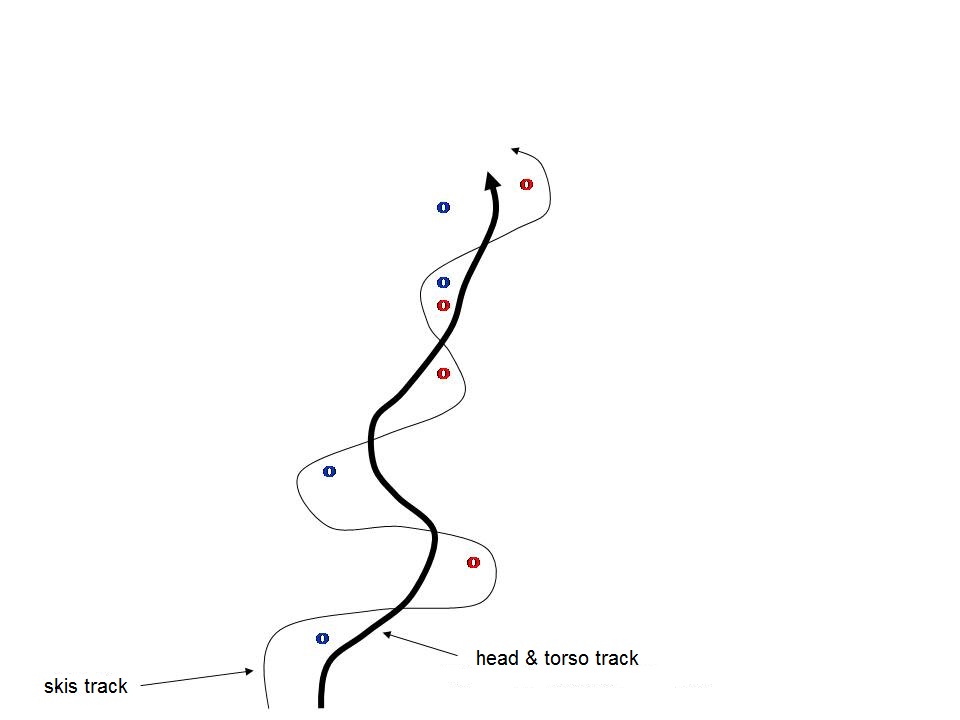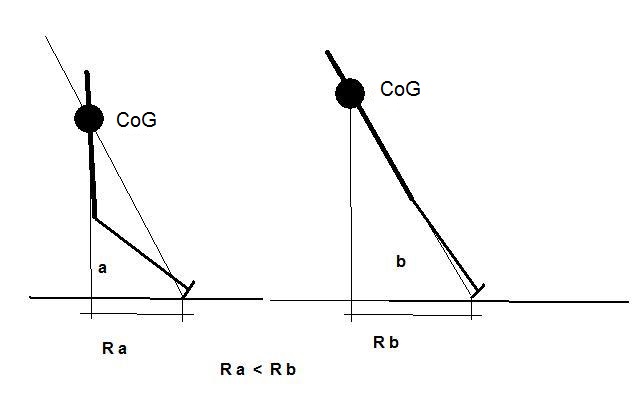various ways of implementation
4.1. What is the inclination?
The skier, like a cyclist in the turn, leans in the middle of the turn to resist centrifugal force. The greater this force is, the greater the inclination of the cyclist and skier is needed. A drawing showing this relationship would certainly be useful here. It would also be useful to recall the formula for the amount of centrifugal force, showing how it depends on the turning radius, linear speed, as well as the weight of the athlete. We should also presume a fairly natural assumption that the skier, like a cyclist, accurately cuts the turn and does not slip (or slips a little), it means, he receives a reaction force from the ground that opposes the centrifugal force generated by the turn. For us it is interesting how to transfer this inclination to faster riding.
In the advanced skier movement, his skis move on a different track and his torso and head travel on a different track. In a turn, the skis first set off to the side, then return under the torso and drive away again, but the other way round. One then talks about ski side sending, and the resulting leaning opposes the emerging centrifugal force of the turn being made. If we look at the track of a moving skier from above, we can see that his center of mass, due to the inclination, moves along a different path than his skis are going. Ski regulations require that a skier must pass through the gate space with both skis and feet – but the torso can slip over the pole. The decisive factor for the speed of the ride is the skier’s center of gravity passage on the shortest route possible. In other words, if the skier’s skis and feet go to pass the gates, then the center of gravity (head and torso) should move as straight as possible. Let’s look at an example when a competitor rides among slalom poles, skis and the center of gravity leave the tracks as shown:

At the places of the maximum distance of both tracks (ski and foot track and the center of gravity track), the skier is leaning to the side as far as possible to the center of the turn. Where the tracks intersect, skis pass under the torso, there is no inclination.
4.2. What to do to make the route of the skier’s centre of gravity as straight as possible
It is necessary to mention elements – requirements that complement the main topic of this chapter, and which have a great influence on the “straightening” of the route.
a. Skis (feet) should ride close to the pole. Let’s make a small calculation: the slalom turning radius is about 15 meters. If we extend this radius by an unnecessary, too large distance between the ski and the pole, e.g. by 45 cm, then due to the linear relationship between the arc length and the radius, our route will be extended by (0.45 / 15) * 100% = 3% . The 3% is a loss of 1.5 seconds on a 50-second slalom!
b. Skis, in the slalom ride, should be led narrowly. When guiding the inner ski close to the pole and correctly distributing the load on both skis, it should be possible to extend the center of gravity as far as possible to the side beyond the pole, i.e. to the center of the slalom.
c. The inner ski that passes the pole the closest should go as far as possible aside. Of course, it should ride away enough not to disturb the correct proportions of loading the outer and inner skis and not to cause a fall. It is worth to work on “every centimeter”. You have to consider the great danger that the inner ski will pass the pole at the wrong side or get into it. Maybe the ski tip should be modified in such a way that after accidental hitting the pole it slips in the right direction?
d. Legs (skis) in individual turns should be “passed” aside as far as possible. This results leaning the knees down in the direction of the snow and putting the skis on the edges. Then the skis are turning, the body of the skier leans to balance the centrifugal force.
e. This is the inclination model mentioned above. The greater the leaning (inclination) is, the skier’s center of gravity goes over the “more straight” track (see the picture above). The size of the centrifugal force, and hence the degree of inclination, is expressed by the formula F = (m * v 2) / r known from high school, which says that the speed of movement (in a square) has the great influence. The turning radius have a decisive influence on the amount of deflection. The parameter on which the skier has an active influence is the possible shortening of the turning radius. For safer ride is an arc with a longer radius. Looking for speed, skier can go a little more towards the pole and try to make a short turn “in place”. The limit here is the construction radius of the skis. Beyond this is the way of shortening the radius is only by the slide or rotating skis in the air. The second limitation is the great centrifugal force generated by the turn with a small radius. The skier and his skis must withstand this strength on his feet and ski edges. It’s a huge effort. Faster slaloms are set for advanced powerful riders. Faster slalom generates the greater force (in a square) on the skier. This verifies his plans and capabilities.
f. When riding between slalom poles, skis and boots are pushed aside, the competitor makes pendulum movements. Either it is made only by the legs, when the torso of the skier stays “vertically” and the axis of rotation of this pendulum is in the hips, or, with longer turns, the athlete puts his whole body, while maintaining the position that allows effective ski edging. In the second case, the axis of rotation of our hypothetical pendulum is above his head. Let’s look at the pictures:

Two ways of the inclination – with and without bending in the hips
Let’s assess the pros and cons of both ways of riding.

The inclination, i.e. the angle between the center of gravity, the fulcrum and the ground, is similar in both cases. This indicates similar parameters of speed, turning radius, and centrifugal force. The positions, however, differ from each other in the distance between the edge of the ski and the projection with the center of gravity (Ra, b). If the skier does not “break” in his hips, but only leans to the side, his center of gravity (CoG) moves away less from the axis of the slalom. Hence, his center of gravity track is shorter, so the racer has the opportunity to pass the slalom faster.
In addition, as can also be seen in the figure, the angle of the shin a) is smaller than the angle b). Hence, with a similar mechanical arrangement, the edging of the inclined skier is smaller than that of the “broken” in the hips skier. Less edging – less ski cutting into the snow, and hence less braking. This is another advantage of swinging leaning.
g. “Supporting” with your inner hand, or rather sliding the guard of the inner stick on the slope, is a common view in slalom turns. It can help to make the largest possible leaning and stabilize it with confidence.
4.3. Can we always use the technique of leaning the entire torso?
a. From school physics, we remember that a pendulum with a longer arm has a lower frequency of fluctuations. So, leaning the whole figure can only be made for longer turns, when the time to make a turn is longer. In hairpins, flushes and gate sets with quick turns only legs must work. Then it is needed a pendulum system with a higher frequency, i.e. with a shorter arm. The skier senses this intuitively and when the turn lasts less than 0.5 seconds throws only skis and feet sideways.
b. Positioning the skis very strongly on the edge (knees to the side), supported by an aggressive way of sharpening the skis, allows you to get the right “bite” the edges of the snow. Then the “bending” in the hips is a necessary mechanism, resulting from centrifugal force, determining the appropriate inclination of the center of gravity with maximum curved skis.